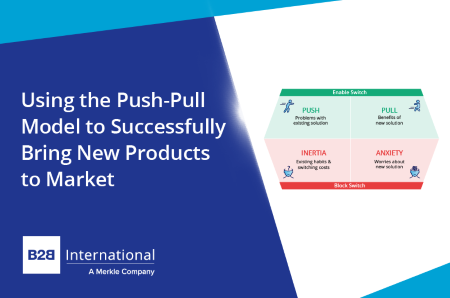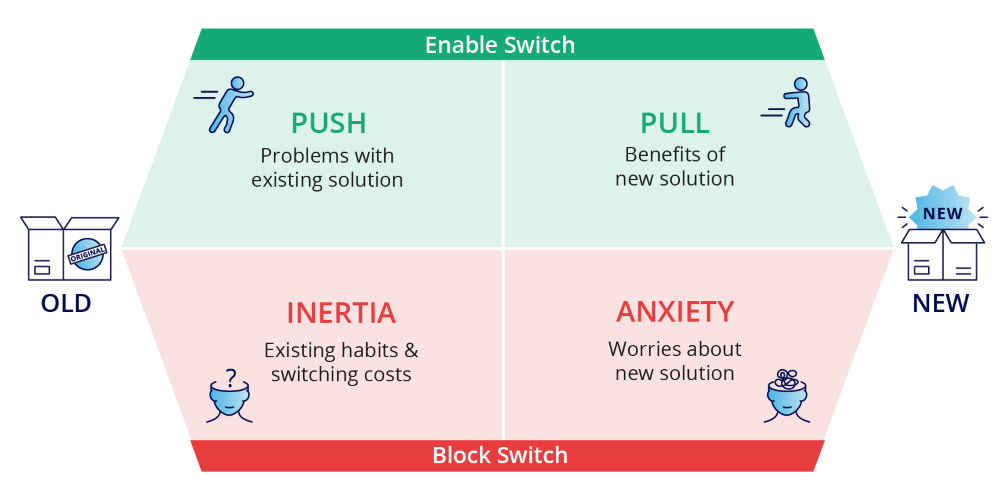
The push-pull model is a framework that is best used when organizations are looking to introduce a new product or solution to the market but are unsure of the enablers and barriers that customers see when thinking about switching solutions. The framework allows us to explore a variety of reasons why customers might want to stick with their current solution or move to use a new product or solution. Through its use, the push-pull model can inform organizations of what is going to enable or block a switch to the new solution, and hence can help to develop strategy to overcome any barriers to the use of the new solution or product.

Understanding the Elements of the Push-Pull Model
There are four different elements to the push-pull model. Two of these elements would encourage a switch to a new solution:
‘Push’: The ‘push’ element of the model is used to identify what would ‘push’ a customer from using their existing solution. In this box, we would include the problems that customers identify with their current solution.
‘Pull’: The ‘pull’ element of the model is used to demonstrate the key benefits of the new solution, that would encourage a switch from the existing solution. In this box, we could highlight where any of the benefits are specific to different customer groups.
Some of the details that sit within each box may overlap, for example, if a problem with the customer’s existing solution is that it is not sustainable, yet the new solution is sustainable, we might see sustainability as both a push from the existing solution, and a pull towards the new solution.
The other two elements of the model are used to highlight factors which would block the switch to a new solution:
‘Inertia’: This element of the model is used to demonstrate the threats which customers identify regarding switching to a new solution (i.e., that would block them from considering a switch). Inertia is often a core reason for continuing to use an existing solution, so we should identify the habits that customers are in in this box, too.
‘Anxiety’: In addition to customers being in the habit of using their existing solution, and the threat of moving away from this solution, there is also anxiety about the new solution that could block the switch. In this element of the model, we should highlight the worries that customers have about the new solution, that might prevent them from switching solution.

Driving Action Using the Push-Pull Model
Once we have established all of the ‘push’, ‘pull’, ‘inertia’ and ‘anxiety’ elements, we can start to use the model to drive action, in order for customers to be more inclined to switch to the new solution. A good way to do this, is to action each box in the push-pull model, so that all bases are covered to encourage a switch to the new solution. An example of how this might look is below.
‘Push’: Communicate the benefits of the new solution which overcome pitfalls in the existing solution. More detailed ‘push’ recommendations might look like:
- Highlight features of the new solution which improve on sustainability performance
- Demonstrate how technical support is improved with the new solution
‘Pull’: Demonstrate the research that has helped to develop the new solution and exemplify the key benefits of the new solution, reflecting the reasons why customers may switch. More detailed ‘pull’ recommendations might look like:
- Outline the return on investment of the new solution, if rising costs are a push factor
- Invest in research to clearly demonstrate the advantages of the new solution
‘Inertia’: Offer support to customers, so that they can see why switching solutions is important. More detailed ‘inertia’ recommendations might look like:
- Develop an example roadmap for the future using the new solution, so that customers can clearly see the direct benefits of switching solutions
- Lobby government to influence change for the future
‘Anxiety’: Demonstrate features of the new solution which can overcome anxieties about switching. More detailed ‘anxiety’ recommendations might look like:
- Highlight research that has been done on the efficacy of the solution
- Demonstrate experience in the field and capabilities of support teams
Readers of this article also viewed:
What to Consider When Evaluating Market Opportunities How Market Research Can Help Guide Your Market Entry Strategy Assessing Market Attractiveness with the Directional Policy Matrix Competitive Landscape Analysis with Porter’s Five Forces Framework B2B Insights Podcast #64: The Best Frameworks to Develop Winning Propositions PESTLE Analysis: Understanding Market Influences for Better Decision-Making SWOT Analysis: Identifying Strengths, Weaknesses, Opportunities & Threats How to Get B2B Concept Testing Right: A Helpful Guide
To discuss how our tailored insights programs can help solve your specific business challenges, get in touch and one of the team will be happy to help.

